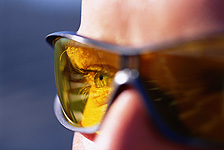Here in Northern Colorado hunters and gun enthusiasts should make use of eye protection. Whether at a shooting range or in the woods eye protection is for everyone. All firearms have some amount of recoil which has injury potential. Also, most shooting activities take place outdoors, where wind, sun, dust, tree branches and brush can all can cause eye injuries.
Pre-made nonprescription sports goggles are usually acceptable if you don’t require vision correction or if you wear contact lenses. Most of these goggles have a wraparound style to shield the eyes from wind and dust. However, lens quality can vary in pre-made goggles. Make sure the lenses are made of polycarbonate, which is the most impact-resistant material available.
Frame features to look for
 Some people in Fort Collins, Loveland and Greeley find that they require prescription lenses in order to focus well, or if you simply want to use the best shooting eyewear available; shooting glasses in styles similar to aviator sunglasses are very popular today.
Some people in Fort Collins, Loveland and Greeley find that they require prescription lenses in order to focus well, or if you simply want to use the best shooting eyewear available; shooting glasses in styles similar to aviator sunglasses are very popular today.
Glasses that are designed specifically for shooters have a greater amount of additional features than the traditional aviator-shaped frame for everyday (or “dress”) wear. More importantly, the frame should be a safety-rated model, with a strong rim to hold the lenses in place. Some styles have a “sweat bar” that runs the width of the frame above the lenses to add more stability to the frame and keep the frame from slipping off the face repeatedly, greatly interfering with safety and performance. This feature is very helpful for people who perspire a lot. There are other glasses that have special padding on the frame around the eyes to cushion the frame against your face in case the gun recoils too far. This also helps to keep wind, debris and dust from getting into your eyes (a great option for windy climates like Northern Colorado and Wyoming) and for people who wear contact lenses.
One great advantage of shooting glasses is that the temples of these glasses are often designed with spring hinges that allow the frame to flex without breaking when recoil occurs. Another popular design of frames that we see are temples that wrap around the ear in the “cable” style to help keep the frame in place on the face while moving quickly.
The addition of adjustable nose pads are usually a popular option because the frame can be fit in the optimum position. Softer silicone pad materials provide additional comfort for extended periods of wear such as hunting trips.
We are seeing the frames of shooting glasses are often constructed of any number of ophthalmic materials, including titanium and other metals, regular plastic and tough polycarbonate.
Choose the right lenses
For many years now shooting glasses have been made with Polycarbonate lenses with a scratch-resistant hard coat and built-in ultraviolet protection. The Polycarbonate lens material is highly impact-resistant and so it is able to provide you the shooter with maximum “blow-back” and “bounce-back” protection. Today, new lens materials have been developed that are also very impact-resistant.
Here in Fort Collins, Loveland and Greeley we are seeing many nonprescription shooting glasses come with several pairs of interchangeable lenses (be careful when changing them out) for use in different lighting conditions to optimize your vision. We have the ability to make prescription lenses to order in whatever color of tint you deem most appropriate.
Many shooters are choosing lenses that are tinted with yellow or orange. While lenses tinted in these hues block haze and blue light and enhance the orange color of the target they offer the advantage to the shooter visually. We have found that the brighter yellow the lens color is, the better it is for use in foggy or low-light conditions.
In contrast, a light purple tint, which is actually a combination of a neutral gray and vermilion, is excellent for improving the orange of the target against a background of tall trees. Vermilion itself is useful to highlight conditions where there is poor background, such as trees, and to enhance the target against the background. Gray is a neutral, or “true,” color that lets you see all colors as they are. Gray shooting lenses do not enhance the target, but they are good in bright sunlight.
Polarized shooting lenses can be made in almost any tint.The benefit of Polarized lenses is that they reduce glare from light bouncing off highly reflective surfaces, making them an excellent choice when hunting near bodies of water.
For additional information or to schedule an appointment, please call 970-204-4020 or click on the link on the side of the page.






